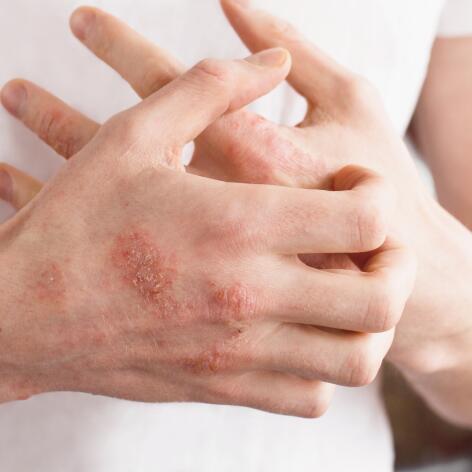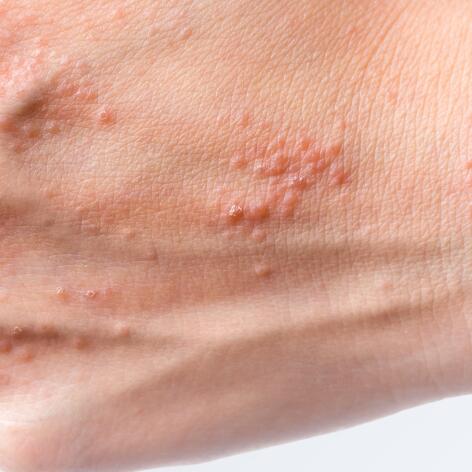Eczema of the hands and feet
- Living with eczema and psoriasis
- Living with eczema and psoriasis: Children
- Psoriasis and eczema for children - rules for moisturizing
- Adults - Care and anti-itching tips
- Living with eczema and psoriasis: Adult
- Psoriasis and adult eczema - rules for moisturizing
- Psoriasis and eczema in children: suitable hygiene
- Psoriasis and eczema in adults: suitable hygiene
- Children - Care and anti-itching tips
Eczema of the hands and feet
Do your hands feel itchy after washing them? Are they painful after using certain household products? Do your feet also bother you, especially when you sweat? It’s possible that your hands and feet are affected by eczema. This skin condition can be painful and debilitating for everyday life and work. Here are our tips on how to relieve it.

How do you recognise hand and foot eczema?
Very dry and thickened skin on the back of the hand, small blisters as if filled with water between the toes, peeling fingertips... These are the most common forms of hand and foot eczema, which can affect all or part of these extremities. This chronic skin disease alternates between flare-ups (blisters, itchy red patches, cracks etc.) and lulls in which the skin remains dry. It is generally aggravated by cold or very hot weather, or by contact with certain irritating substances. Eczema of the hands and feet can have several causes, which are not always easy to identify.
FRIENDLY (AND EXPERT) ADVICE
“When cleaning, you should remember to wear gloves, as they protect your hands from irritating products”.
Tatiana
What causes hand and foot eczema?
Hand and foot eczema can be caused by several factors.
Contact eczema
This is an allergic reaction to a specific allergen. On the hands, it is triggered by the presence of certain household products, cosmetics etc. Certain jobs are particularly exposed to these allergens. On the feet, the material of socks or shoes is often the cause.
Atopic eczema
There is no specific allergy in this case, but a genetic predisposition that makes the skin more permeable to all allergens. The skin on the hands is not spared from the daily stresses of life. On the feet, eczema is more localised on the ankle and the top than on the sole.
Dyshidrosis, the other cause of hand and foot eczema
If your itching is caused by small, very painful blisters filled with a transparent liquid and which are triggered especially in the spring or summer, then your eczema of the hands and feet is probably caused by dyshidrosis, also called bullous eczema. Its origin is not well known, but it mostly develops on an atopic surface. There are several factors that trigger or promote this type of eczema: allergies to certain metals (nickel, cobalt), heat, excessive sweating, foot fungus, etc. It appears along the fingers and toes, on the palm of the hand and the sole of the foot.

FRIENDLY (AND EXPERT) ADVICE
It’s important to identify what triggers hand and foot eczema.
The first thing to do is to find out if your hands or feet are reacting to a particular allergen (an allergist can help you with this). If so, you should avoid contact with that allergen as much as possible — for example, by protecting your hands when washing dishes, or by choosing cotton rather than synthetic materials for your socks.
However, it’s possible that no specific cause can be identified. The good news is that whatever the cause, the treatment of hand and foot eczema is based on the same principle: dermocorticoids at the time of flare-ups and daily moisturizing during the lull, to space out these outbreaks.

Best practices to relieve eczema on the hands and feet
Emollient creams, which restore the skin's barrier function and protect it from allergens, are perfect for moisturizing and soothing hands and feet affected by eczema. They should be applied with gentle massages, several times a day if necessary. Cotton gloves and socks can optimise their moisturizing effect. Some creams are also specifically designed to isolate the skin of the hands from irritants, forming a transparent, protective glove-like barrier.
Our solutions to relieve hand and foot eczema
Eau Thermale Avène products designed to soothe eczema on the hands and feet.
- Lipid-Replenishing Cleansing Oil
XeraCalm
Lipid-Replenishing Cleansing OilNourishes - Soothes - Cleanses - Soothing concentrate
Best Seller
XeraCalm
Soothing concentrateNourishes - Soothes - Restores - Repairs
Which skin care routine should you adopt?
Identify what it really needs with the help of our experts and discover the most suitable skin care routine for you.



